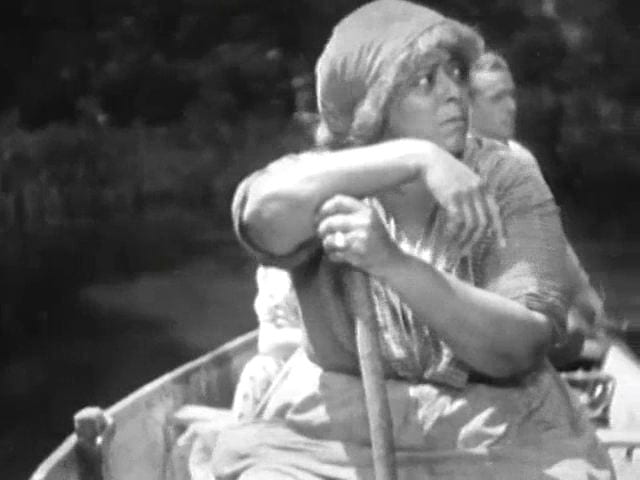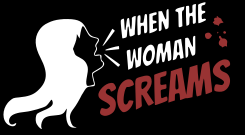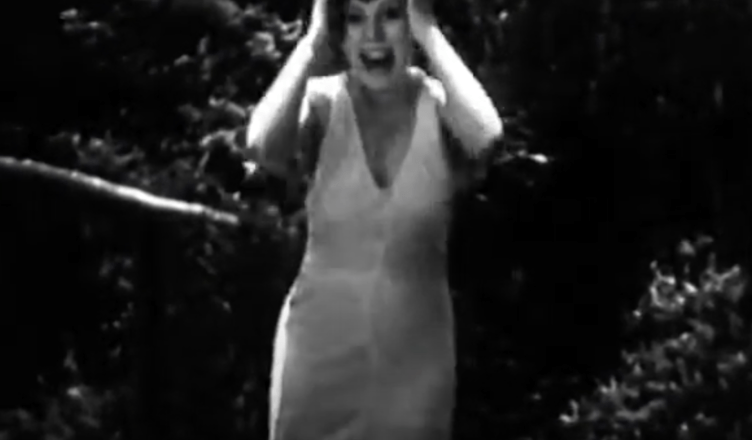Film Deets:
Director: Marshall Neilan
Screenplay: Marshall Neilan
Actresses: Georgette Harvey, Olive Borden
Category: Systemic White Supremacy
Themes: Racism, Xenophobia
Why do these screams matter?
Directed by Marshall Neilan, Chloe, Love is Calling You (1934) is a deeply racist horror film that demonstrates the role early horror cinema played in codifying and transmitting structural white supremacy. The film opens with Mandy’s (Georgette Harvey) return to the bayou after having fled years earlier in the wake of her husband’s lynching. She is accompanied by her daughter Chloe (Olive Borden) and Jim (Philip Ober), a friend of the family. When Mandy’s plan to exact revenge on those who murdered her husband meets unanticipated obstacles, secrets are revealed that pit mother against daughter.
In its summation of the film, Black Horror Films notes that “what begins as a standard “tragic mulatto” tale quickly devolves into some sort of “white is right” propaganda that, while perhaps not as intentionally racist as, say, Birth of a Nation, nonetheless delivers twisted, jaw-dropping morals.” The blatant white supremacy conveyed in the film reinforces harmful stereotypes that later horror films exploit in depictions of a racial “Other.” This is particularly evident in its casting of Mandy as a maniacal, vengeance seeking woman with access to the supernatural through her practice of voodoo. Her personal history, which includes the death of her child and the lynching of her husband, is weaponized against her such that Mandy’s function in the film is to contrast against and highlight Chloe’s innocence and purity. In her compelling reframing of Mandy as an enduring woman heroine, Robin R. Means Coleman argues that in Chloe, “all parts of Blackness are represented as wicked. Black men are physically and sexually predatory, Black religions are an abomination, and Black communities are a breeding ground for all manner of cultural deficiency that must be overseen and managed” (163).
To understand what is being transmitted through the screams of this film, it is first necessary to understand the political environment in which it was made. In 1932, nine young Black men were accused of raping two white young women in Alabama. Concerns over a mob-fueled lynching prompted the trial to be moved to Scottsboro and quickly resulted in unjust convictions which wouldn’t be formally overturned until 2013 when posthumous pardons were finally granted by the Alabama legislature. This court case crystallized the impact of the era’s Jim Crow laws, legislation that enforced racial segregation and disenfranchised Black people. It is this cultural backdrop that informs much of the politics of Chloe, Love is Calling You.
In our first scream, these politics come into play when Chloe is accosted by two men as she walks through town. Despite her objections, one of the men, Mose (J. Augustus Smith), refuses to take no for an answer and drags her into the bar. When Wade (Reed Howes), Chloe’s love interest attempts to intervene, Mose draws a gun much to Chloe’s horror.
This scene is especially interesting for how it highlights historically harmful framings of Black men as dangerous. From the outset, Mose is cast as a degenerate who is a threat to the safety of Chloe. Because this film takes place in the Louisiana swamps, Mose already occupies a space of marginality. He is demarcated as outside the mainstream community by virtue of his race, economic class, and religion. The decision to then show Mose drinking and gambling, two behaviors framed as debauched by moral watchdog groups of the time, is designed to evoke mistrust in the audience and to position Mose as someone whose comfort with violating social norms renders him suspect.
But it is also a questionable departure from how white men who drank and gambled in film were typically depicted. While religious leaders were still anti-alcohol, the general public was starting to push back against Prohibition and this resistance is reflected in films of the era (Lacey). By the 1930s, alcohol consumption on screen was no longer automatically associated with problematic vice. Films such as International House (1933), The Thin Man (1934) and It’s a Gift (1934) all play characters acting inebriated and disorderly for laughs. Indeed, when Mose sees Chloe and drunkenly tells his friend to “watch my smoke” before trying to get her attention, the moment only teeters on being threatening. Even his manhandling of Chloe, abusive as it is, would not have read especially violent to audiences of the time conditioned to seeing disinterested women aggressively pursued by would-be suitors. But the characters in the aforementioned films were all white men whose vices are framed as humorous. This is not the case for Mose. Chloe’s screams ensure that the audience reads him as a threat and that no space is created to see the character as anything other than a Big Bad.
Yet, Chloe’s screams are fueled by fear that is expressly race based and steeped in white supremacy. Throughout the film, Chloe repeatedly distances herself from her Blackness such that when it is revealed Chloe is actually white and the daughter of the wealthy Colonel Gordon (Francis Joyner), Chloe immediately cuts ties with her Black family and friends. She believes that being Black means that she is somehow less than her white peers, and it is this perspective that the audience is being asked to align with through Chloe’s screams.
The implied threat posed by Mose is made explicit in our next screams in which Chloe is assaulted by Mose as Hill (Jess Cavin), another disgruntled worker, watches.
 On the surface, this scene is a fairly standard-for-the-time deployment of the damsel in distress trope in which a young woman in crisis needs to be saved, often by a handsome would-be suitor. But an overview of Hollywood films illustrates this to be a trope based almost wholly in whiteness, as neither the damsel in distress nor her rescuer are usually portrayed by people of color. This sends a message that purity and heroism are reserved for white people; a message only amplified when the two villains are played by Black actors. Chloe’s screams are the traditional auditory markers of the damsel in distress trope and remind the audience of her “purity,” here a code for her virginity that Mose threatens.
On the surface, this scene is a fairly standard-for-the-time deployment of the damsel in distress trope in which a young woman in crisis needs to be saved, often by a handsome would-be suitor. But an overview of Hollywood films illustrates this to be a trope based almost wholly in whiteness, as neither the damsel in distress nor her rescuer are usually portrayed by people of color. This sends a message that purity and heroism are reserved for white people; a message only amplified when the two villains are played by Black actors. Chloe’s screams are the traditional auditory markers of the damsel in distress trope and remind the audience of her “purity,” here a code for her virginity that Mose threatens.
The framing of white womanhood at risk from the threat of Black male sexuality is deeply rooted in historical oppression. When directed at a Black man by a white woman, allegations of rape were used to justify lynching. As Megan Armstrong notes, “White people would often excuse the lack of trial (and instead lynch the accused man) on the basis that white women and girls should be spared the mortification of testifying in court” (37). This resulted in violent lynchings that were often provoked by false allegations. Riché Richardson writes:
Though the black male body was scripted in post-Emancipation racialist thought as an imminent sexual threat to white femininity, the emergence of the black rapist myth during this time-along with its concomitant rationalization in the social terror of lynching-has been more accurately interpreted as less a reflection of reality of white female rape than a public and ritualized manifestation of growing white panic about a shifting social order in the South that promised blacks education, property, political participation, and social inclusion (59).
Chloe perpetuates this trope by having Mose be the one to attempt the assault while Hill simply watches. Because Hill is white, the suggestion is that though he is leering and grotesque in his voyeurism, he still won’t cross the line that Mose does. Consequently, Chloe’s screams here are transmitting multiple messages simultaneously. Her screams are a legitimate response to the threat of rape and they are designed to signal her fear and hope to be rescued. But they also codify the idea that Black men (and only Black men) are a danger to white women. Chloe’s screams direct the audience to share Chloe’s perspective regarding the unfolding events. But because her perspective is bound up in anti-Blackness, this point of view sharing becomes just another way to transmit white supremacy.
The prioritizing of a world view that centers whiteness is also at play in our final scream. As Mandy instructs that Chloe be bound and prepared for sacrifice as part of a voodoo ritual, drums start playing, igniting Chloe’s terror.
Voodoo rarely fares well in horror films. Instead of offering nuanced depictions of the Haitian religion vudun and its ceremonies, film often relegates the religion to the fringes by associating it with black magic. Certainly, that’s the framing we get in Chloe. Depictions like this create an us/them dichotomy in which the practice of voodoo is perceived as explicitly anti-American. John P. Bartkowski explains that this framing is an intentional way to separate vudun from “mainstream” religions: “Combining ideological suspicion for “foreign,” putatively “non-Christian” groups on the one hand with racial prejudice for nonwhite purveyors of new religions on the other represents a redoubled effort to impose a deviant label upon such groups” (566). For a 1933 audience, memory of the 1915 United States Occupation of Haiti in which Marines were sent to occupy Port-au-Prince to protect American business interests would weigh heavily and likely inform their reaction to the film’s voodoo ritual. As much of the news of the occupation frequently “involved an explicit racialization of Haitians and Haitian religious practice,” this scene ceases to become just another element of the film and instead morphs into another way to transmit xenophobia (Lowe). Chloe’s screams then are less a fright response and more a response to the Otherness that surrounds her. These screams are the film’s final racist reminder that its Black characters inhabit a space of savagery while its white characters represent aspirational civilization.
Works Cited
Armstrong, Megan. “From Lynching to Central Park Karen: How White Women Weaponize White Womanhood.” Hastings Women’s Law Journal vol. 32, no. 1 (Winter 2021): 27-50.
Bartkowski, John P. “Claims-making and typifications of voodoo as a deviant religion: Hex, Lies, and Videotape.” Journal for the Scientific Study of Religion (1998): 559-579.
Blakemore, Erin. “Jim Crow Laws Created ‘Slavery’ by Another Name.” National Geographic, 5 Feb. 2020.
Coleman, Robin R. Means. “The Enduring Woman: Race, Revenge, and Self-Determination in Chloe, Love is Calling You.” Edited by Norma Jones, Maja Bajac-Carter and Bob Batchelor, Heroines of Film and Television: Portrayals in Popular Culture, Rowman & Littlefield Publishers, 2014, pp.163-176.
Cose, Ellis. “The Saga of the Scottsboro Boys.” ACLU, 27 July 2020.
Harris, Mark H. “Chloe, Love is Calling You (1934).” Black Horror Movies
Lacey, Liam. “Drinking in the Movies: A Short History, Straight Up. The Globe and Mail, 26 October 2012.
Lowe, Lenny. “Occupation and the Occult.” The Black Atlantic, 2014.
Richardson Riché. Black Masculinity and the U.S. South: From Uncle Tom to Gangsta. University of Georgia Press, 2007.






